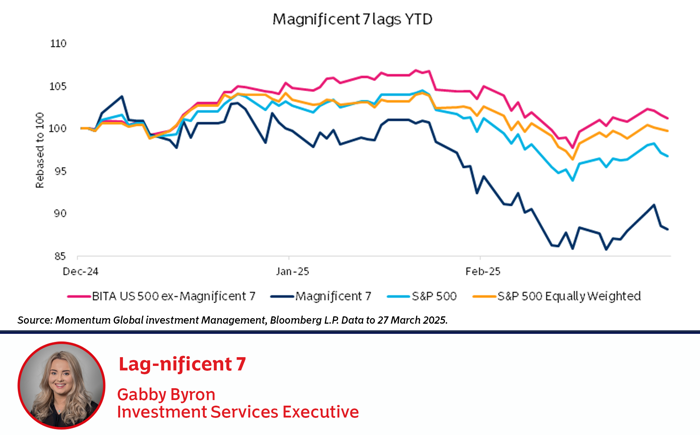
What this chart shows
The chart compares the year-to-date performance of the S&P 500, a market cap-weighted index of the Magnificent 7, the equal-weighted S&P 500 as well as the BITA US 500 ex-Magnificent 7 Index. While this handful of stocks drove returns in 2023 and 2024, their dominance has faded so far in 2025, with the group underperforming an equal-weighted approach.
Why this is important
Market leadership changes over time, and history suggests that extreme concentration in a small group of stocks rarely lasts indefinitely. Similar trends played out after the dot-com boom, when a handful of high-growth names eventually gave way to broader market participation. The recent underperformance of the Magnificent 7 highlights the risk of excessive exposure to a small group of names, especially when valuations are stretched.
For portfolio positioning, this shift reinforces the case for diversification. We've recently introduced exposure to an equal-weighted S&P 500 fund in some of our portfolios to help reduce reliance on those dominant names and capture opportunities across a broader range of companies. As the name suggests, the equal-weighted fund assigns an equal weight to all 500 companies within the S&P 500, reducing the concentration risk inherent in traditional market cap weighted indices. So far in 2025, smaller weighted companies within the S&P 500 have outperformed and the equal-weighted structure has allowed their performance to make a more meaningful impact. On top of this, the emergence of DeepSeek significantly impacted major tech stocks at the end of January, triggering a sharp sell-off in AI related stocks, with Nvidia falling 17% in a single day. While mega-cap tech remains a core part of the market, a more balanced approach may offer better returns as leadership rotates.
President Donald Trump's announcement of a 25% tariff on all imports of foreign-made cars and parts has significantly impacted global markets, raising concerns about inflation, economic growth, and the potential for a broader trade war.

-
President Trump announced a 25% tariff on all imports of foreign-made cars and parts, effective April 2 for vehicles and May 3 for auto parts.
-
Core PCE rose 0.4% in February, pushing the year-on-year rate up to 2.8%. Additionally, the University of Michigan survey showed long-term inflation expectations hitting a 32-year high.
-
US consumer confidence has hit a 12-year low, raising concerns about future spending and potential economic downturns.
-
Financial markets are bracing for volatility due to new "reciprocal" tariffs on various trading partners, with analysts predicting persistent inflation and slower economic growth.

-
Chancellor Rachel Reeves presented the Spring Statement, emphasising the need to stabilise public finances amid global trade uncertainties. The latest measures include benefit changes and reforms to public services.
-
The UK government faces economic threats from US protectionist policies, including recent tariffs on UK car imports and potential future tariffs on pharmaceuticals.
-
The Office for Budget Responsibility warned that a US-initiated trade war could nullify the UK's fiscal savings, potentially leading to higher taxes or further spending cuts.
-
Headline CPI for February was down to 2.8% vs 3.0% expected, leading markets to dial up rate cut expectations at the next Bank of England meeting in May.

-
The EU is considering retaliatory measures in response to the US's new car tariffs, including potential tariffs on US goods.
-
European markets are experiencing volatility due to concerns over escalating trade tensions between the US and EU.
-
The European Central Bank is closely monitoring inflation data and the impact of US tariffs on the region's economy.
-
EU leaders are exploring negotiated solutions to avoid a full-scale trade war with the US, aiming to protect the European economy.

-
China’s official manufacturing activity grew by its fastest pace in a year, coming in at 50.5. This saw the Chinese composite PMI expand to 51.4 in March from 51.1 in the month prior.
-
Analysts are closely watching China's policy responses to US trade actions, anticipating potential adjustments to maintain economic stability.
-
The Bank of Japan has signalled the possibility of interest rate hikes if inflationary pressures persist, adding complexity to the economic outlook.
-
International businesses are reassessing supply chains and market strategies in light of new tariffs and trade barriers.
